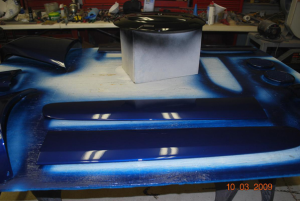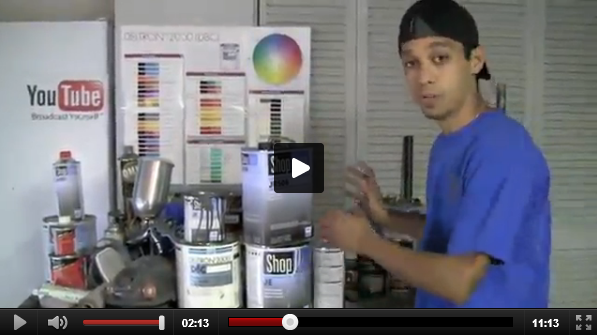It’s vitally important to discover what type of paint is currently on the surface of your vehicle to avoid ruining your paint job.
“Acrylic Enamel Paint, Acrylic Lacquer Auto Paint or Urethane Paints…”
“Learn How to Determine the Type of Paint on Your Vehicle Using the Vehicle Identification Number and an Awesome Simple Method You Can Easily Accomplish at Home”
Before high-tech polyurethane paint products were introduced, cars were painted using either acrylic enamel paint or acrylic lacquer auto paint. Each offered its own unique characteristics.
Acrylic enamel paints being quick and easy to work with, generally covered in one or two coats and didn’t require any clear coat or rubbing out.
Acrylic lacquer auto paint however, required multiple coats, but allowed imperfections to be easily rubbed out and quickly repainted. The fast drying time enabled the painter to fix surface blemishes almost immediately.
Although both acrylic enamel paint and acrylic lacquer auto paint products offer specific benefits, they cannot be used together on car bodies due to their incompatibility with one another.
With surfaces properly prepared and under proper conditions, it wouldn’t be a problem to spray acrylic enamel paint over acrylic lacquer auto paint.
However, applying acrylic lacquer auto paint over acrylic enamel paint will almost always result in wrinkling or other severe surface blemishes.
- Enamel sprayed over Lacquer
- Lacquer sprayed over Enamel
This is due to the solvent base in acrylic lacquer auto paint (lacquer thinner) being too potent for the soft materials used in acrylic enamel paint products.
Product compatibility is just as important today. This isn’t confined to simply enamel, lacquer or urethane paints either.
Every product in an entire paint system must be compatible with the surface material to which it will be applied, as well as with every other product in the system.
This is very important to the success of any paint project.
For example, using a PPG reducer with a BASF hardener in a DuPont paint product is asking for real trouble.
The individual products were not designed as parts of a single compatible paint system and as a result, the color, adhesion and surface flow of that combination may well be adversely affected.

How to determine the type of paint currently on your vehicle:
Before you purchase paint for your car, you need to find out what type of paint material currently exists on the surface of your vehicle, whether it be enamel, lacquer or urethane paints.
In the case of newer vehicles, all factory paint jobs are going to be urethane based, as enamels and lacquers are quickly being done away with.
For your vehicle, it may be worth asking your local auto paint supply store member of staff for information on what kind of paint was applied at the factory.
To discover this for yourself, there should be a specific paint code listed on the vehicles ID tag.
In addition, you will also be able to determine the exact type of paint and color from the vehicle identification number (VIN) on older vehicles or from a separate paint and options tag on newer vehicles.
This all helps to easily identify materials when you are planning to match the existing paint.
If your vehicle has been repainted since it left the factory, you will need to obtain the paint code numbers from the paint can used during the repaint.
If this is not possible, contact the person who performed the repaint to attain the required information from them.
If you cannot determine the specific paint codes or information relating to the type of paint used on your car, you yourself will have to test a hidden spot on the vehicle using lacquer thinner, you could even possibly test an area already allocated for a repaint.
Take a clean white cloth, wet it with lacquer thinner and rub a spot of paint to test the reaction.
If the color comes off immediately or the spot starts wrinkling, it shows that the type of paint is enamel.
But if the color wipes off onto the white cloth only after vigorous rubbing, it is a sign of lacquer paint.
If nothing wipes off onto the cloth, the paint is probably urethane based.
How to determine if your car is coated with clear coat:
To find out if the finish on your vehicle includes coats of clear paint over its base color, simply sand a hidden spot using 600-grit or finer sandpaper.
A white sanding residue shows that there exists a clear coat finish. A color residue shows that only a color material was used to paint the body with.
Before applying fresh paint on the vehicle, it is vitally important to find out exactly what type of paint is currently on the surface.
About the only exception to this rule is when a totally new paint system has to be taken into consideration after bringing the vehicle body down to its base metal.
If you are at all unsure about the type of paint on your car after this test, or if you have any other related questions or problems, our advice would be to consult a professional auto paint supply store member of staff.
Remember, applying mismatched coatings to an existing finish can potentially ruin your whole paint job.
I hope you liked this blog. Talk soon! Bye!
-Tony
Did you enjoy the blog? Check out the LABAP VIP course that will help turn you into an auto body and paint pro, from home!
Other Helpful Links:
The Importance of Wax and Grease Remover on Auto Undercoat and Top Coat
How To Reduce Pollution When Spray Painting A Vehicle
Learn Auto Body and Paint Q&A – Auto Bodywork Tips and Answers
How To Inspect A Car For Body Damage | Telltale Signs a Car Was Painted or Was in a Collision
How and Why You Need To Use Wax and Grease Remover Before a Paint Job


Tony, You are the best, thanks for sharing. Have the greatest of holidays !
Thank you Phil! You too 🙂
do you have to paint a sealer over a enamel paint if you want to re paint with a bc/cc?
Hey Todd, thanks for sending in your LABAP Question! However, it’s very difficult to reply here as I’m not much of a typist. If you are not yet VIP, head on over to this link here to get comprehensive access to information on auto body work and paint: https://www.learnautobodyandpaint.com/vip-offer/
You may also sign up for our FREE forum at The Pub to post your questions and interact with other like minded individuals here: https://pub.learnautobodyandpaint.com/
Finally, join me in my live streams through my YouTube channel and directly connect with me with your most burning question on auto body work and paint. Subscribe to the channel to get notified when we go live: https://www.youtube.com/user/HowToPaintYourCar
Very impressive, thank you Tony, but didn’t say nothing about acrylic
urethane compatibility for example with acrylic laquaer clear coat.
It will be interested to know your though. Thank you for advance, Mike.
Hey Mike! Why don’t you join me in my live streams so let’s talk more about your most burning questions on auto body! Hey, don’t forget to grab your FREE manual if you still haven’t: https://learnautobodyandpaint.com/free-autobody-manual
great job of explaining paint differences and how to determine paint types. thank you so much for your expertise and your time. good things happen to good people. you are a good person
Thanks for the awesome feedback! We really appreciate it. Hey don’t forget to grab your free manual if you still haven’t: https://learnautobodyandpaint.com/free-autobody-manual
Hi Tony. I have a 64.5 mustang which is in good shape body wise but the paint is a bit of a disaster in that when the car was converted to RHD some of the panels were obviously painted with Base Coat and Clear but other parts of the vehicle appear as if they may be the original paint from the factory which may mean that it is enamel. I intend to repaint the car with your advise and training with Base Coat and lacquer. When I was talking to my local paint shop they said I should not have any problems painting base coat and clear straight over the original paint. The original pain seems sound but is obviously very dull. What do you think of their advice. I do not want to have to take the vehicle back to bare metal if I do not have to
Hey Steve, it’s quite difficult to give my advice here especially since I haven’t seen the car! However, I discuss that in my VIP training in detail! Grab your free manual and get started learning more about auto body work and paint: https://learnautobodyandpaint.com/free-autobody-manual